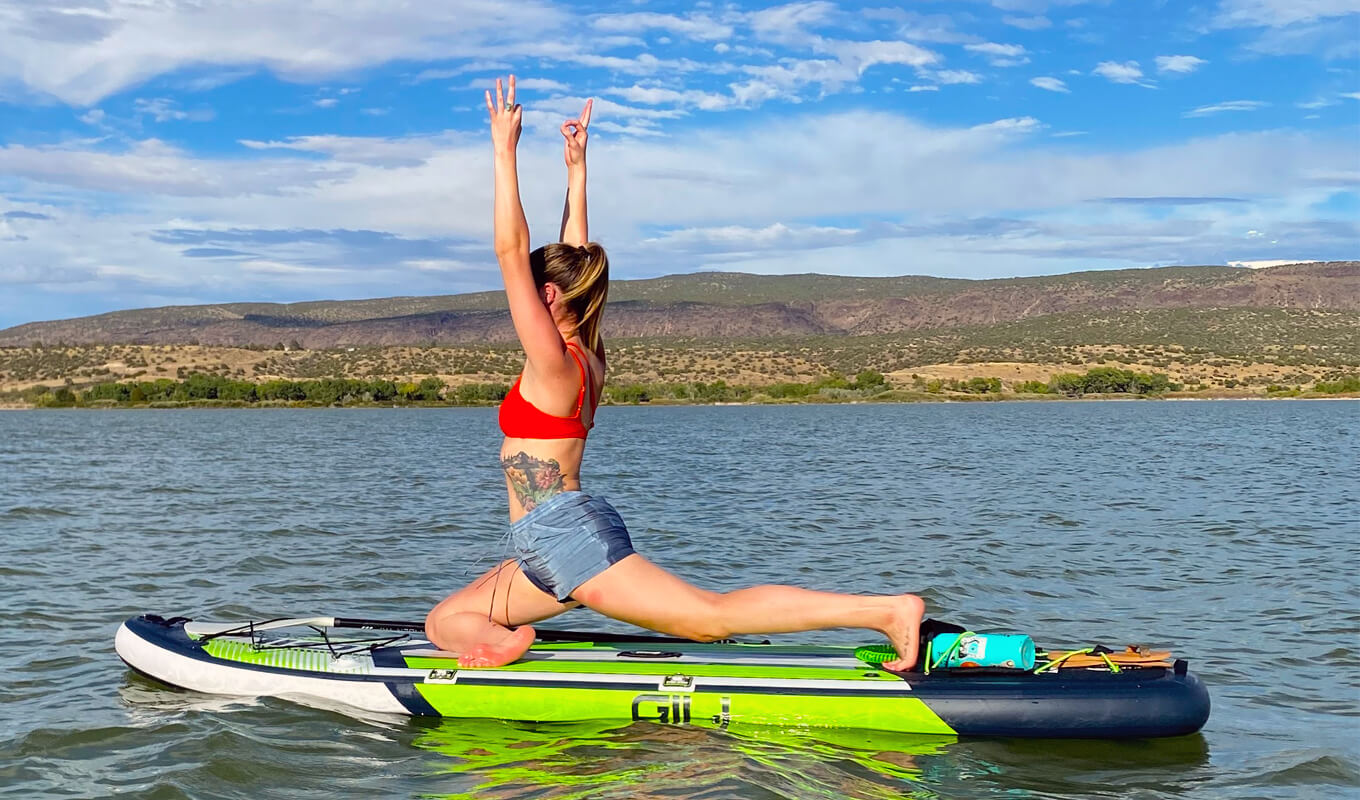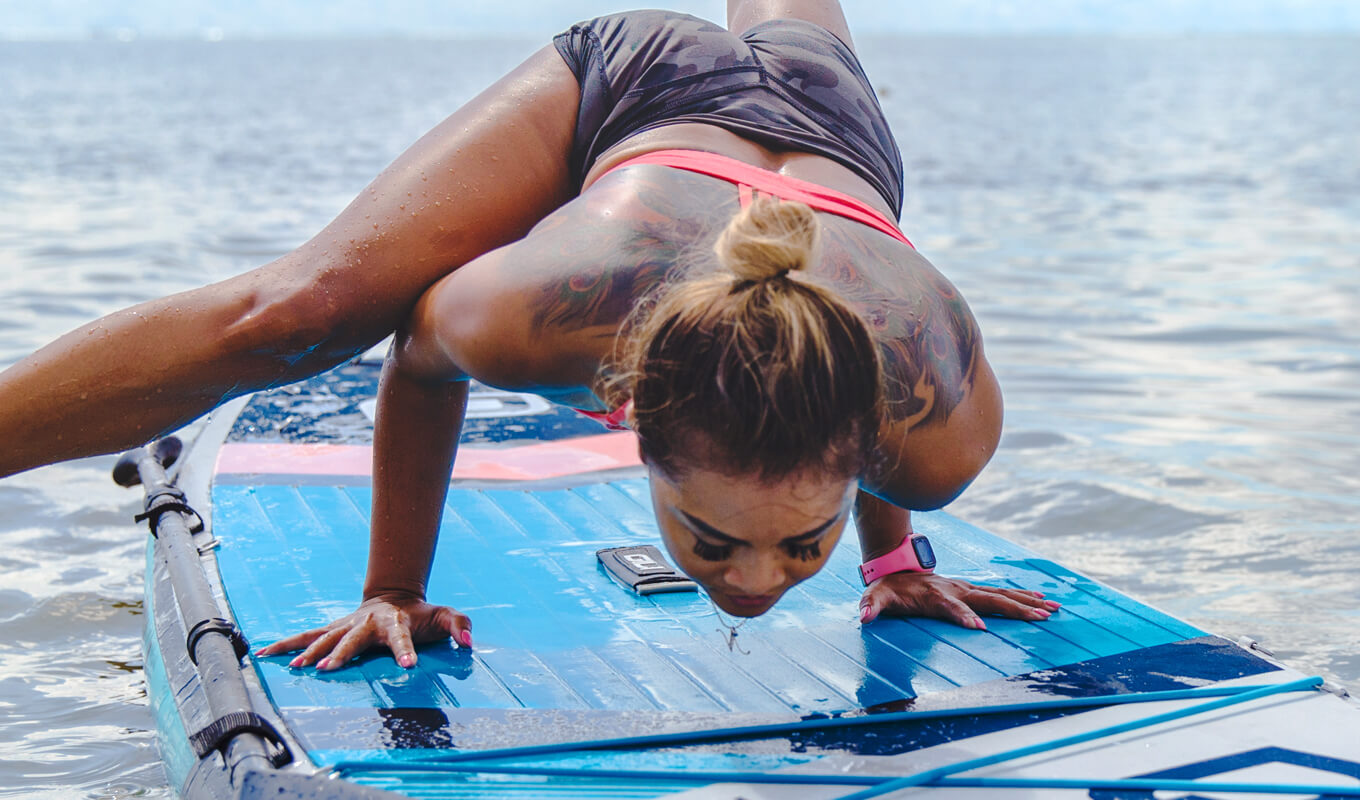Your Cart is Empty
FREE SHIPPING ON ORDERS OVER £39.99
FREE SHIPPING ON ORDERS OVER £39.99


Paddle boarding is becoming more and more popular with it, so have SUP activities like paddle board yoga.
If you’re new to the SUP yoga world, we have curated a list of the top 10 SUP yoga poses anyone can do to help you channel your inner yogi, all from the comfort of your SUP.
Paddle board yoga is exactly what it sounds like, practicing the sport of yoga on a paddle board. What makes SUP yoga practice so different from your traditional land yoga practice, however, is the fact that you have to find a new level of balance.
On land, practicing yoga, especially the more complex moves, can be quite challenging. Throw a roughly 34” floating platform into the mix, and you have a whole new set of skills to work on.
Although SUP yoga is a huge step up from land-based yoga, it is a fantastic workout for even the most experienced yogi, and in our opinion, there is nothing more tranquil than practicing yoga poses in a secluded waterway fully immersed by nature.

You could be the best yogi in the world, but if you don’t equip yourself with the right paddle board, it could all end in disaster.
The best type of stand up paddle board to use is an all-around board like the GILI Komodo or the GILI Meno.
Both the Komodo and Meno are excellent paddle boards for practicing your yoga routine because of their 33”+ wide decks. Out of the two, the Meno takes the upper hand, as its 35” deck will provide the perfect stable platform for you to carry out your SUP yoga poses.
As well as deck width, you want a board that is comfortable. We highly recommend inflatable paddle boards as opposed to hard top boards for SUP yoga, as the soft squishy deck of an inflatable won’t cause you any harm if you happen to fall out of a pose unexpectedly.
We have gone into more detail about which paddle boards are suitable for yoga over on Best Paddle Boards for Yoga: A Comprehensive Guide.
Before you head out on your paddle board, there are a few tips to keep in mind:
Now that we’ve gone over some SUP yoga top tips let’s get into 10 beginner and intermediate yoga moves. We’ve even added a few harder moves at the end for those wanting slightly more of a challenge.

The first pose on our paddle boarding yoga list is the boat pose which does an exceptional job of strengthening the muscles throughout your core.
To increase the level of difficulty you can straighten out your legs and reach your arms above your head. You could even perform boat crunches by lowering your legs and bringing them back up to your original boat pose.

The bridge pose can be modified to different intensity levels depending on your skillset. You can start with your arms resting on your SUP and progress to a full wheel-bridge pose.
Once you’ve mastered the basic bridge pose, you can upgrade to the full-wheel bridge pose, also known as a backbend.

The chair pose is one of the easier poses on the list and helps you practice your balance while also strengthening your core and leg muscles. The closer your feet are together, the harder this pose becomes, so start with your feet roughly a hip-distance apart and build up your balance until your feet are next to each other.

A great finishing pose for both land and SUP yoga is the child's pose. If you’ve ever taken a class with a certified yoga instructor, you’ll know all about this move. The child's pose stretches out your hips, ankles, and thighs while also helping you to relax your mind and body.

The downward facing dog pose helps to tone your arms and legs, strengthen your shoulders, and stretch out the muscles in your calves, hamstrings, and spine. There are a few variations of the downward facing dog, with some adaptations to make the pose easy for beginners.
If you’re struggling to perform the downward-facing dog, try and master the upward-facing dog.

This one is slightly on the more tricker balance scale, but it does an incredible job of stretching out your hips and quadriceps.

Our next paddle board yoga instruction is for the plank pose, which is another pose that can be modified to make it more or less intense. Planks reduce the stress on our spine and engage a wide range of muscles from our neck all the way down to our legs. When performed properly, you should feel the burn running throughout your core muscles.
For a more challenging plank pose, bring your arms down, so you’re resting on your forearms. Alternatively, for a slightly less challenging pose, you can remain on your hands or rest on your forearms and bring your knees on the deck to help distribute the weight.

The easiest, most relaxing, and most attainable move is the savasana. Once you’ve finished all your yoga poses, we highly recommend spending a few minutes in this pose to truly relax your mind and calm your body.

If you have tension in your shoulders, upper back, and neck, then the thread the needle pose is an excellent way to open up and rid yourself of that unwanted stress.

You’ll need to use some balance for this one, but once you’ve mastered it, you’ll be working on your stamina, concentration, and strength in your legs.
So, now that you’ve mastered all the beginner SUP yoga poses, here are some slightly more challenging poses that require a lot more balance, strength, and stamina.

The crow pose is mainly performed to strengthen the muscles in the arms and core. In our opinion, it’s one of those moves that truly makes you feel like a yogi once you’ve got the hang of it.

Although the Garland Pose is fairly simple, it does require some balance while on your paddle board. It’s highly beneficial to our bodies as it helps to open up our hips and also improves our range of motion.

Quite possibly the hardest move on the list, and that is a headstand. Headstands are extremely tricky on land, let alone on a moving floating platform, but if you’ve mastered the rest of our suggested yoga moves, then it’s time for you to move onto the expert poses.

The final move on our list is the wide leg standing forward fold. This pose strengthens and stretches your hamstrings, calves, spine, and hips while also engaging your arm, shoulder, and upper back muscles.
SUP yoga isn’t much different from your regular on-land yoga; however, you need to pay extra close attention to your balance. Most yoga moves can be performed on a SUP if you just think of your paddle board as your yoga mat.
If you can’t do a yoga pose, the best thing to do is to practice an easier variation of the pose. For example, if you can’t hold a full plank on your elbows, try and hold it on your hands or bring your knees down for extra support.
If you continuously practice these easier variations, you’ll be able to perform the original pose in no time.
Touring SUPs have thin decks as their purpose is to be able to slice through the water at high speeds. To perform yoga moves, you need a slightly wider surface area to help improve your overall balance.
This isn’t to say that it is impossible to practice SUP yoga on a touring SUP, but it would be extremely hard to remain on the board while holding some specific poses.
We have gone into more information about the best paddle board to use for yoga over in our article How to Choose a Paddle Board for SUP Yoga.
Comments will be approved before showing up.